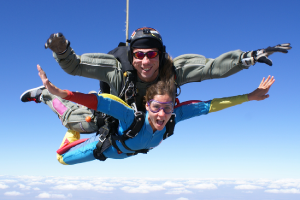3 MYTHS ABOUT SKYDIVING TO LEAVE ON THE GROUND

To some people, especially those afraid of heights, skydiving sounds like a terrifying prospect. After all, a normal attitude for skydiving is around 13,000 feet, which gives the jumper just about 60 seconds of free fall to watch the ground hurtle ever closer.
Even though this sounds like a dangerous pastime, skydiving, also known as parachuting, is a safe and enjoyable activity. Don’t let rumors get in the way of your adventurous thrill-seeking. Here are four myths about skydiving that are simply not true.
1. Skydiving is Dangerous
As stated before, skydiving is not as dangerous as it sounds. Skydiving equipment is heavily regulated, monitored, and tested, all in order to make this activity as safe as possible. In addition, as a first time jumper, you do not simply strap on skydiving equipment and jump out of a plane. Instead, your first time skydiving is often done as a tandem jump with a more experienced skydiver. During your first tandem jump, you and the professional skydiver are directly attached to each other. This allows the professional skydiver to fully control your actions while skydiving, preventing any accidents from occurring.
2. Skydiving Will Hurt
Some people think that skydiving can hurt. They envision violent gut-wrenching jerks the parachute deploys, or tumbling when they land on the ground, or by being blown off course and crashing into a tree.
However, all of these perceptions are false. When the parachute opens during your first tandem jump, it does so gradually, allowing a gradual decrease in speed, preventing whiplash. Landing itself is also not very painful, since modern parachute designs allow professional skydivers to apply ‘brakes’ when landing. Finally, it’s unlikely that you’ll land on a tree when skydiving, since most drop zone locations are completely free or natural or man-made obstacles.
3. You Can’t Breathe or Speak While Skydiving
The first part of this myth is blatantly false. The majority of parachuting occurs at around 13,000 feet, which, although it sounds high, it’s an altitude that still contains plenty of oxygen. The second half of this myth, however, is actually true. Unlike what you may have seen in movies, the wind moving around you while skydiving is loud enough to drown out any verbal communication between your and the professional skydiver. To communicate while skydiving, jumpers use series of hand signals instead.
Your first tandem jump can be a scary prospect. However, skydiving can also be a unique and amazing experience. Remember to ignore these three myths next time you consider skydiving. With the facts set straight, you may finally decide to take the leap!